Analysis of Monetary Policy and Its Impact on the Economy
VerifiedAdded on 2022/09/08
|8
|1436
|13
Report
AI Summary
This report delves into the intricacies of monetary policy and its influence on the economy. It begins by examining the tools central banks use to regulate money supply, such as interest rates, overnight policy rates, and open market operations, and analyzes the impact of lowering statutory reserve requirements on money supply, interest rates, output, and prices. The report further explores the problem of asymmetric information in financial markets, focusing on its effects on the credit channel and the transmission of monetary policy impulses to the real sector via the bank lending channel. Finally, the report discusses the role of institutions, including central and commercial banks, in shaping economic growth, highlighting the use of expansionary and contractionary monetary policies to stabilize the economy and foster investment.
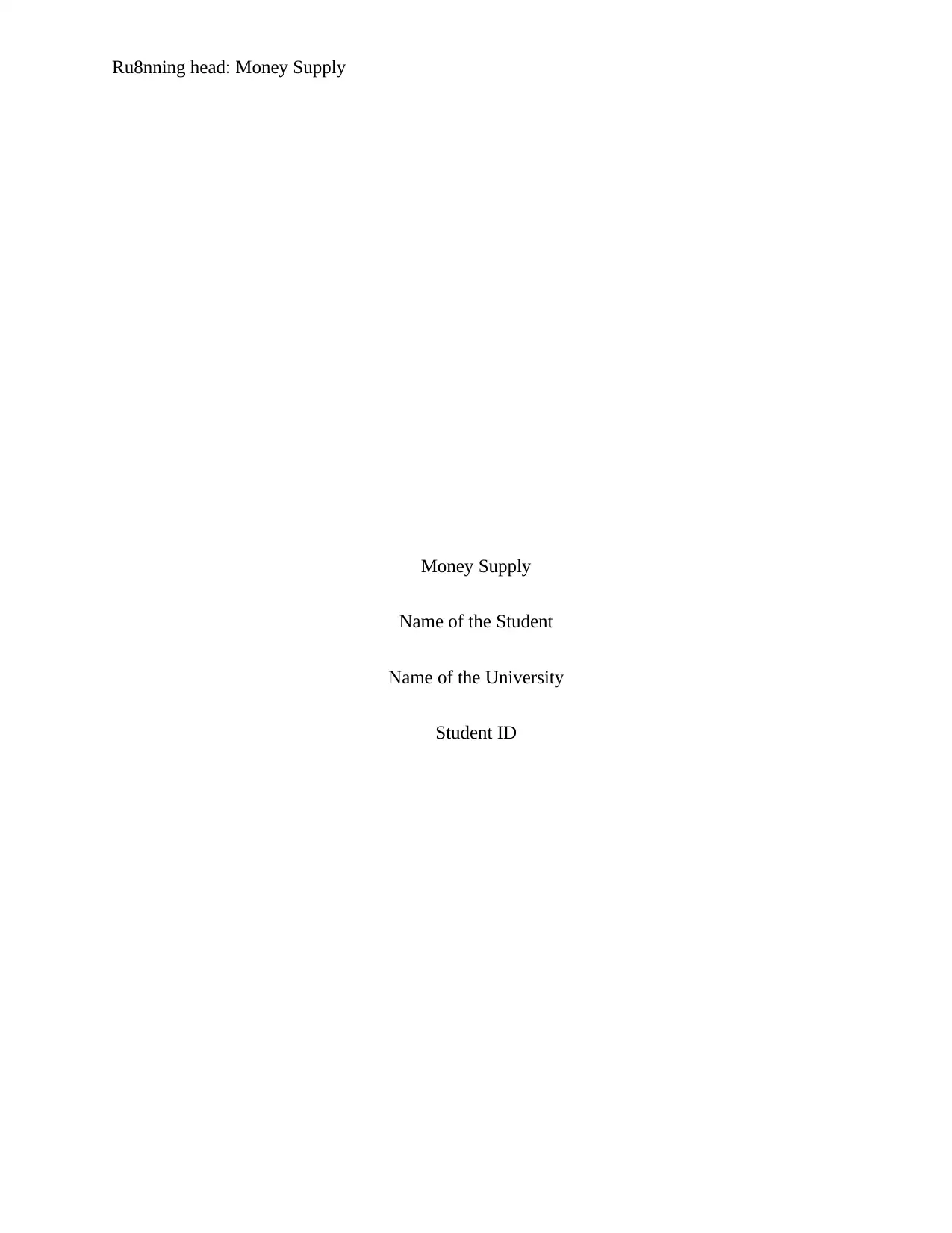
Ru8nning head: Money Supply
Money Supply
Name of the Student
Name of the University
Student ID
Money Supply
Name of the Student
Name of the University
Student ID
Paraphrase This Document
Need a fresh take? Get an instant paraphrase of this document with our AI Paraphraser

1Money Supply
Table of Contents
Answer 1..........................................................................................................................................2
Answer 2..........................................................................................................................................3
Answer 3..........................................................................................................................................4
Reference.........................................................................................................................................6
Table of Contents
Answer 1..........................................................................................................................................2
Answer 2..........................................................................................................................................3
Answer 3..........................................................................................................................................4
Reference.........................................................................................................................................6
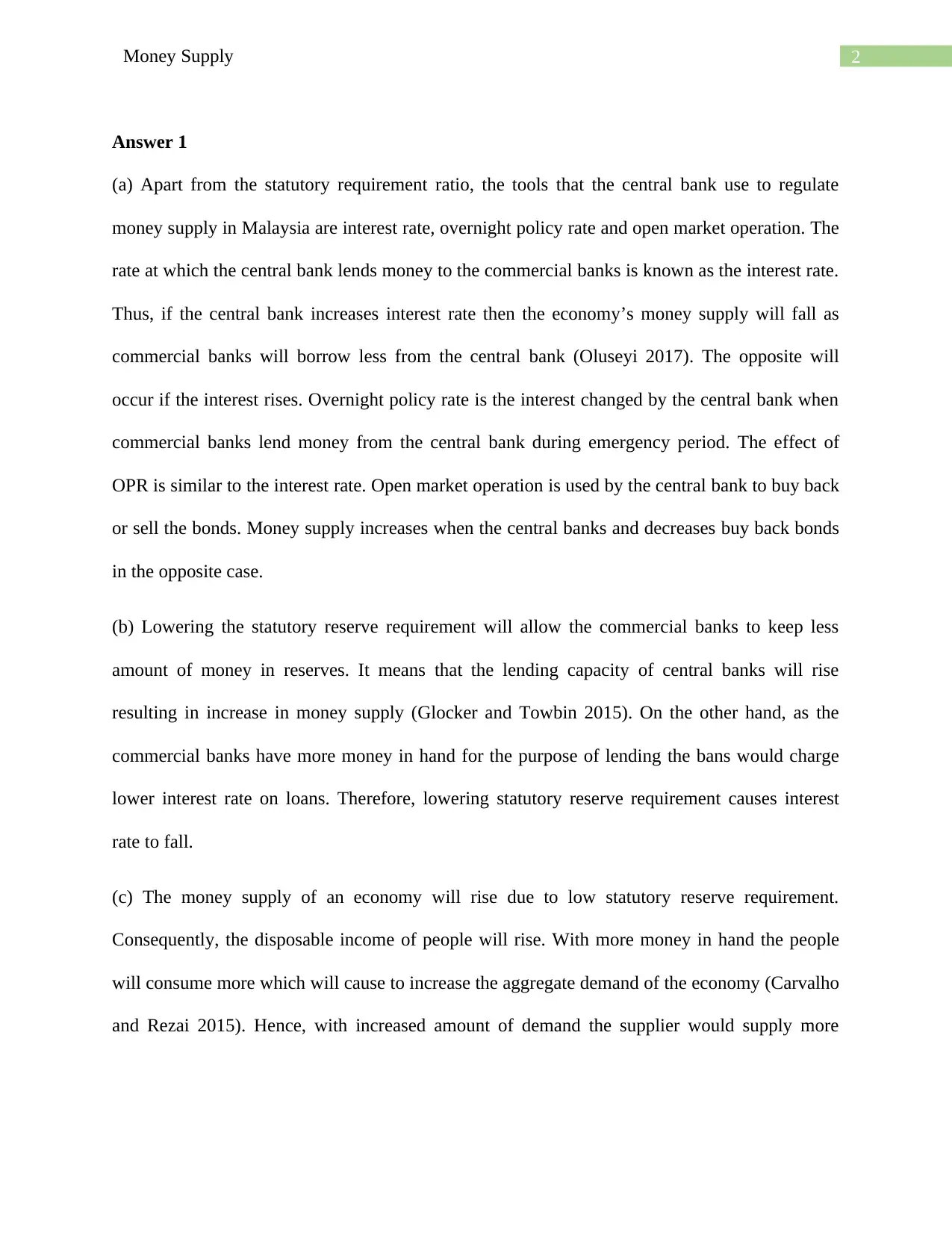
2Money Supply
Answer 1
(a) Apart from the statutory requirement ratio, the tools that the central bank use to regulate
money supply in Malaysia are interest rate, overnight policy rate and open market operation. The
rate at which the central bank lends money to the commercial banks is known as the interest rate.
Thus, if the central bank increases interest rate then the economy’s money supply will fall as
commercial banks will borrow less from the central bank (Oluseyi 2017). The opposite will
occur if the interest rises. Overnight policy rate is the interest changed by the central bank when
commercial banks lend money from the central bank during emergency period. The effect of
OPR is similar to the interest rate. Open market operation is used by the central bank to buy back
or sell the bonds. Money supply increases when the central banks and decreases buy back bonds
in the opposite case.
(b) Lowering the statutory reserve requirement will allow the commercial banks to keep less
amount of money in reserves. It means that the lending capacity of central banks will rise
resulting in increase in money supply (Glocker and Towbin 2015). On the other hand, as the
commercial banks have more money in hand for the purpose of lending the bans would charge
lower interest rate on loans. Therefore, lowering statutory reserve requirement causes interest
rate to fall.
(c) The money supply of an economy will rise due to low statutory reserve requirement.
Consequently, the disposable income of people will rise. With more money in hand the people
will consume more which will cause to increase the aggregate demand of the economy (Carvalho
and Rezai 2015). Hence, with increased amount of demand the supplier would supply more
Answer 1
(a) Apart from the statutory requirement ratio, the tools that the central bank use to regulate
money supply in Malaysia are interest rate, overnight policy rate and open market operation. The
rate at which the central bank lends money to the commercial banks is known as the interest rate.
Thus, if the central bank increases interest rate then the economy’s money supply will fall as
commercial banks will borrow less from the central bank (Oluseyi 2017). The opposite will
occur if the interest rises. Overnight policy rate is the interest changed by the central bank when
commercial banks lend money from the central bank during emergency period. The effect of
OPR is similar to the interest rate. Open market operation is used by the central bank to buy back
or sell the bonds. Money supply increases when the central banks and decreases buy back bonds
in the opposite case.
(b) Lowering the statutory reserve requirement will allow the commercial banks to keep less
amount of money in reserves. It means that the lending capacity of central banks will rise
resulting in increase in money supply (Glocker and Towbin 2015). On the other hand, as the
commercial banks have more money in hand for the purpose of lending the bans would charge
lower interest rate on loans. Therefore, lowering statutory reserve requirement causes interest
rate to fall.
(c) The money supply of an economy will rise due to low statutory reserve requirement.
Consequently, the disposable income of people will rise. With more money in hand the people
will consume more which will cause to increase the aggregate demand of the economy (Carvalho
and Rezai 2015). Hence, with increased amount of demand the supplier would supply more
⊘ This is a preview!⊘
Do you want full access?
Subscribe today to unlock all pages.

Trusted by 1+ million students worldwide
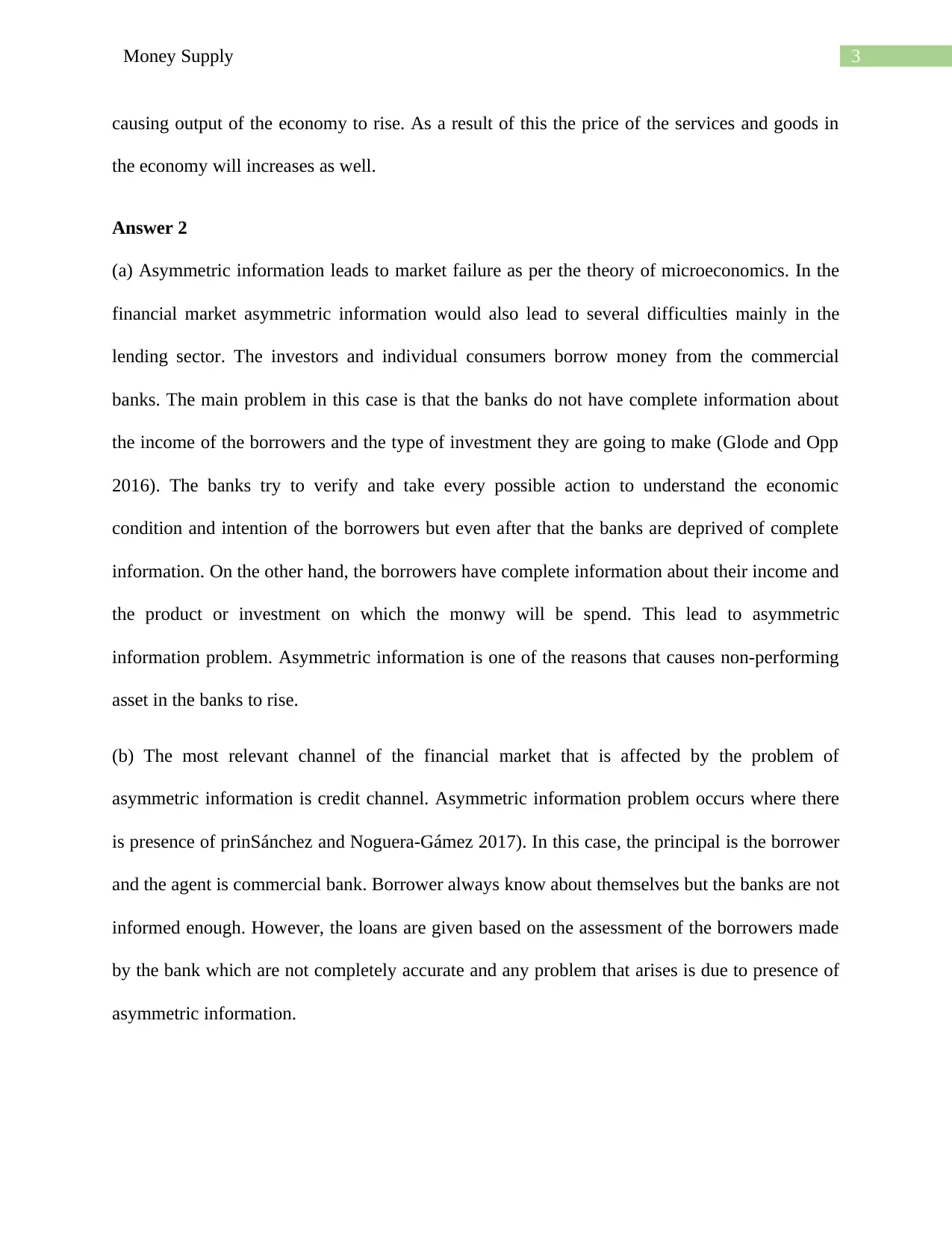
3Money Supply
causing output of the economy to rise. As a result of this the price of the services and goods in
the economy will increases as well.
Answer 2
(a) Asymmetric information leads to market failure as per the theory of microeconomics. In the
financial market asymmetric information would also lead to several difficulties mainly in the
lending sector. The investors and individual consumers borrow money from the commercial
banks. The main problem in this case is that the banks do not have complete information about
the income of the borrowers and the type of investment they are going to make (Glode and Opp
2016). The banks try to verify and take every possible action to understand the economic
condition and intention of the borrowers but even after that the banks are deprived of complete
information. On the other hand, the borrowers have complete information about their income and
the product or investment on which the monwy will be spend. This lead to asymmetric
information problem. Asymmetric information is one of the reasons that causes non-performing
asset in the banks to rise.
(b) The most relevant channel of the financial market that is affected by the problem of
asymmetric information is credit channel. Asymmetric information problem occurs where there
is presence of prinSánchez and Noguera‐Gámez 2017). In this case, the principal is the borrower
and the agent is commercial bank. Borrower always know about themselves but the banks are not
informed enough. However, the loans are given based on the assessment of the borrowers made
by the bank which are not completely accurate and any problem that arises is due to presence of
asymmetric information.
causing output of the economy to rise. As a result of this the price of the services and goods in
the economy will increases as well.
Answer 2
(a) Asymmetric information leads to market failure as per the theory of microeconomics. In the
financial market asymmetric information would also lead to several difficulties mainly in the
lending sector. The investors and individual consumers borrow money from the commercial
banks. The main problem in this case is that the banks do not have complete information about
the income of the borrowers and the type of investment they are going to make (Glode and Opp
2016). The banks try to verify and take every possible action to understand the economic
condition and intention of the borrowers but even after that the banks are deprived of complete
information. On the other hand, the borrowers have complete information about their income and
the product or investment on which the monwy will be spend. This lead to asymmetric
information problem. Asymmetric information is one of the reasons that causes non-performing
asset in the banks to rise.
(b) The most relevant channel of the financial market that is affected by the problem of
asymmetric information is credit channel. Asymmetric information problem occurs where there
is presence of prinSánchez and Noguera‐Gámez 2017). In this case, the principal is the borrower
and the agent is commercial bank. Borrower always know about themselves but the banks are not
informed enough. However, the loans are given based on the assessment of the borrowers made
by the bank which are not completely accurate and any problem that arises is due to presence of
asymmetric information.
Paraphrase This Document
Need a fresh take? Get an instant paraphrase of this document with our AI Paraphraser

4Money Supply
(c) The monetary policy is a macroeconomic policy that impacts all of the economy. The
monetary policy impacts the interest of the loans provided by the banks. Thus, the channel is in
effect in this part is the lending channel (Jimenez et al. 2019). Expansionary monetary policy
would lower lending interest rate of the banks and consequently the economy’s money supply
will increase causing the real sector of the economy to expand (Firceri, Loungani and Zdzienicka
2018). The opposite of the same would occur if the action of the central bank causes the
commercial bank’s lending interest rate to increase. The central bank does this by using statutory
reserve requirement, central banks interest rate and overnight policy rate.
Answer 3
(a) According to Douglas C North the institutions that impact the economic growth of a country
are operated by human formulated constraints. The institutions are central bank, commercial
banks and non-banking financial institutions (Kidwell et al. 2016). The central bank is the apex
body that controls all the commercial banks. They also set guideline that the commercial banks
and non-banking financial institutions had to follow. The central bank sets reserve requirement,
overnight policy rate, interest rate and other rules and regulations for functioning of other
financial institutions. On the other hand the commercial banks and non-banking financial
institutions directly deals with the market.
(b) Economic growth is one of the important factor of a country that is impacted by the
institutions. The policies that the institutions take to influence the economic growth of a country
are expansionary and contractionary monetary policy (Nelson, Pinter and Theodoridis 2018).
When the economy of a country suffers from slowdown the expansionary policy is used. The
contractionary policy is used when economy faces high inflation and unwanted growth rate. The
commercial banks is the executioner of these policies as the lending channel is run by them.
(c) The monetary policy is a macroeconomic policy that impacts all of the economy. The
monetary policy impacts the interest of the loans provided by the banks. Thus, the channel is in
effect in this part is the lending channel (Jimenez et al. 2019). Expansionary monetary policy
would lower lending interest rate of the banks and consequently the economy’s money supply
will increase causing the real sector of the economy to expand (Firceri, Loungani and Zdzienicka
2018). The opposite of the same would occur if the action of the central bank causes the
commercial bank’s lending interest rate to increase. The central bank does this by using statutory
reserve requirement, central banks interest rate and overnight policy rate.
Answer 3
(a) According to Douglas C North the institutions that impact the economic growth of a country
are operated by human formulated constraints. The institutions are central bank, commercial
banks and non-banking financial institutions (Kidwell et al. 2016). The central bank is the apex
body that controls all the commercial banks. They also set guideline that the commercial banks
and non-banking financial institutions had to follow. The central bank sets reserve requirement,
overnight policy rate, interest rate and other rules and regulations for functioning of other
financial institutions. On the other hand the commercial banks and non-banking financial
institutions directly deals with the market.
(b) Economic growth is one of the important factor of a country that is impacted by the
institutions. The policies that the institutions take to influence the economic growth of a country
are expansionary and contractionary monetary policy (Nelson, Pinter and Theodoridis 2018).
When the economy of a country suffers from slowdown the expansionary policy is used. The
contractionary policy is used when economy faces high inflation and unwanted growth rate. The
commercial banks is the executioner of these policies as the lending channel is run by them.
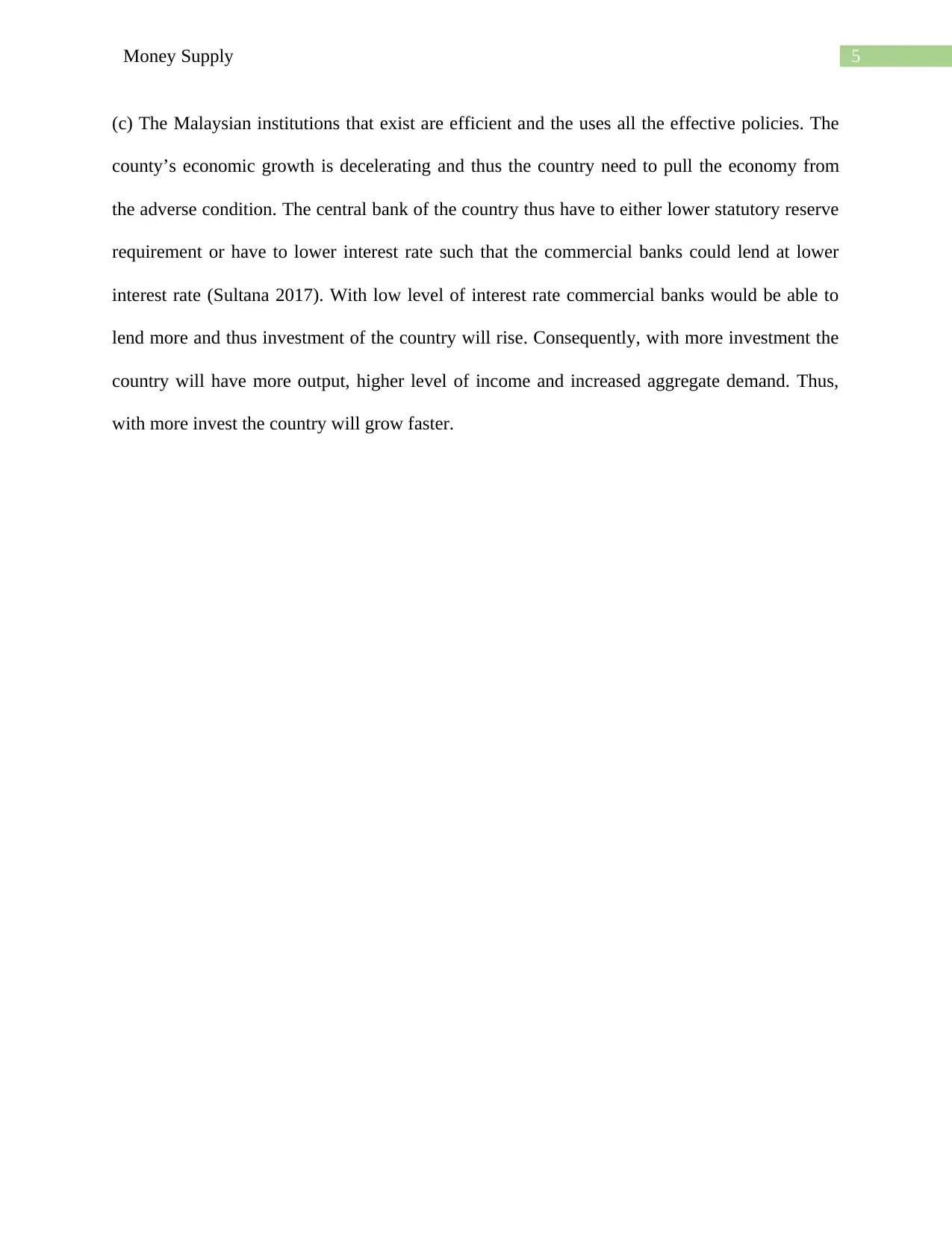
5Money Supply
(c) The Malaysian institutions that exist are efficient and the uses all the effective policies. The
county’s economic growth is decelerating and thus the country need to pull the economy from
the adverse condition. The central bank of the country thus have to either lower statutory reserve
requirement or have to lower interest rate such that the commercial banks could lend at lower
interest rate (Sultana 2017). With low level of interest rate commercial banks would be able to
lend more and thus investment of the country will rise. Consequently, with more investment the
country will have more output, higher level of income and increased aggregate demand. Thus,
with more invest the country will grow faster.
(c) The Malaysian institutions that exist are efficient and the uses all the effective policies. The
county’s economic growth is decelerating and thus the country need to pull the economy from
the adverse condition. The central bank of the country thus have to either lower statutory reserve
requirement or have to lower interest rate such that the commercial banks could lend at lower
interest rate (Sultana 2017). With low level of interest rate commercial banks would be able to
lend more and thus investment of the country will rise. Consequently, with more investment the
country will have more output, higher level of income and increased aggregate demand. Thus,
with more invest the country will grow faster.
⊘ This is a preview!⊘
Do you want full access?
Subscribe today to unlock all pages.

Trusted by 1+ million students worldwide
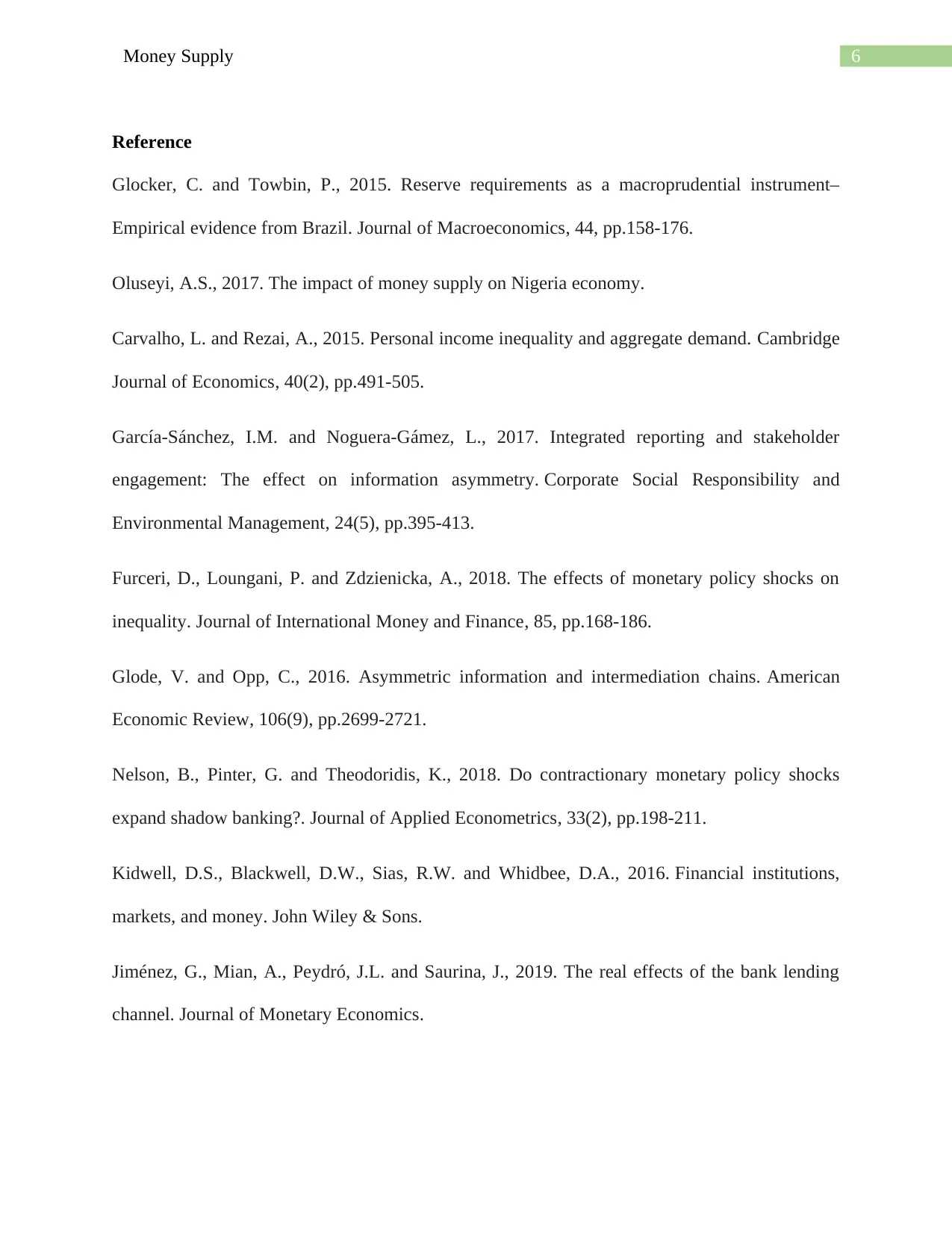
6Money Supply
Reference
Glocker, C. and Towbin, P., 2015. Reserve requirements as a macroprudential instrument–
Empirical evidence from Brazil. Journal of Macroeconomics, 44, pp.158-176.
Oluseyi, A.S., 2017. The impact of money supply on Nigeria economy.
Carvalho, L. and Rezai, A., 2015. Personal income inequality and aggregate demand. Cambridge
Journal of Economics, 40(2), pp.491-505.
García‐Sánchez, I.M. and Noguera‐Gámez, L., 2017. Integrated reporting and stakeholder
engagement: The effect on information asymmetry. Corporate Social Responsibility and
Environmental Management, 24(5), pp.395-413.
Furceri, D., Loungani, P. and Zdzienicka, A., 2018. The effects of monetary policy shocks on
inequality. Journal of International Money and Finance, 85, pp.168-186.
Glode, V. and Opp, C., 2016. Asymmetric information and intermediation chains. American
Economic Review, 106(9), pp.2699-2721.
Nelson, B., Pinter, G. and Theodoridis, K., 2018. Do contractionary monetary policy shocks
expand shadow banking?. Journal of Applied Econometrics, 33(2), pp.198-211.
Kidwell, D.S., Blackwell, D.W., Sias, R.W. and Whidbee, D.A., 2016. Financial institutions,
markets, and money. John Wiley & Sons.
Jiménez, G., Mian, A., Peydró, J.L. and Saurina, J., 2019. The real effects of the bank lending
channel. Journal of Monetary Economics.
Reference
Glocker, C. and Towbin, P., 2015. Reserve requirements as a macroprudential instrument–
Empirical evidence from Brazil. Journal of Macroeconomics, 44, pp.158-176.
Oluseyi, A.S., 2017. The impact of money supply on Nigeria economy.
Carvalho, L. and Rezai, A., 2015. Personal income inequality and aggregate demand. Cambridge
Journal of Economics, 40(2), pp.491-505.
García‐Sánchez, I.M. and Noguera‐Gámez, L., 2017. Integrated reporting and stakeholder
engagement: The effect on information asymmetry. Corporate Social Responsibility and
Environmental Management, 24(5), pp.395-413.
Furceri, D., Loungani, P. and Zdzienicka, A., 2018. The effects of monetary policy shocks on
inequality. Journal of International Money and Finance, 85, pp.168-186.
Glode, V. and Opp, C., 2016. Asymmetric information and intermediation chains. American
Economic Review, 106(9), pp.2699-2721.
Nelson, B., Pinter, G. and Theodoridis, K., 2018. Do contractionary monetary policy shocks
expand shadow banking?. Journal of Applied Econometrics, 33(2), pp.198-211.
Kidwell, D.S., Blackwell, D.W., Sias, R.W. and Whidbee, D.A., 2016. Financial institutions,
markets, and money. John Wiley & Sons.
Jiménez, G., Mian, A., Peydró, J.L. and Saurina, J., 2019. The real effects of the bank lending
channel. Journal of Monetary Economics.
Paraphrase This Document
Need a fresh take? Get an instant paraphrase of this document with our AI Paraphraser

7Money Supply
Sultana, N., 2017. Reserve Accumulation and Sterilization: Aspects and Challenges for the
Central Bank.
Sultana, N., 2017. Reserve Accumulation and Sterilization: Aspects and Challenges for the
Central Bank.
1 out of 8
Related Documents
Your All-in-One AI-Powered Toolkit for Academic Success.
+13062052269
info@desklib.com
Available 24*7 on WhatsApp / Email
![[object Object]](/_next/static/media/star-bottom.7253800d.svg)
Unlock your academic potential
Copyright © 2020–2025 A2Z Services. All Rights Reserved. Developed and managed by ZUCOL.




